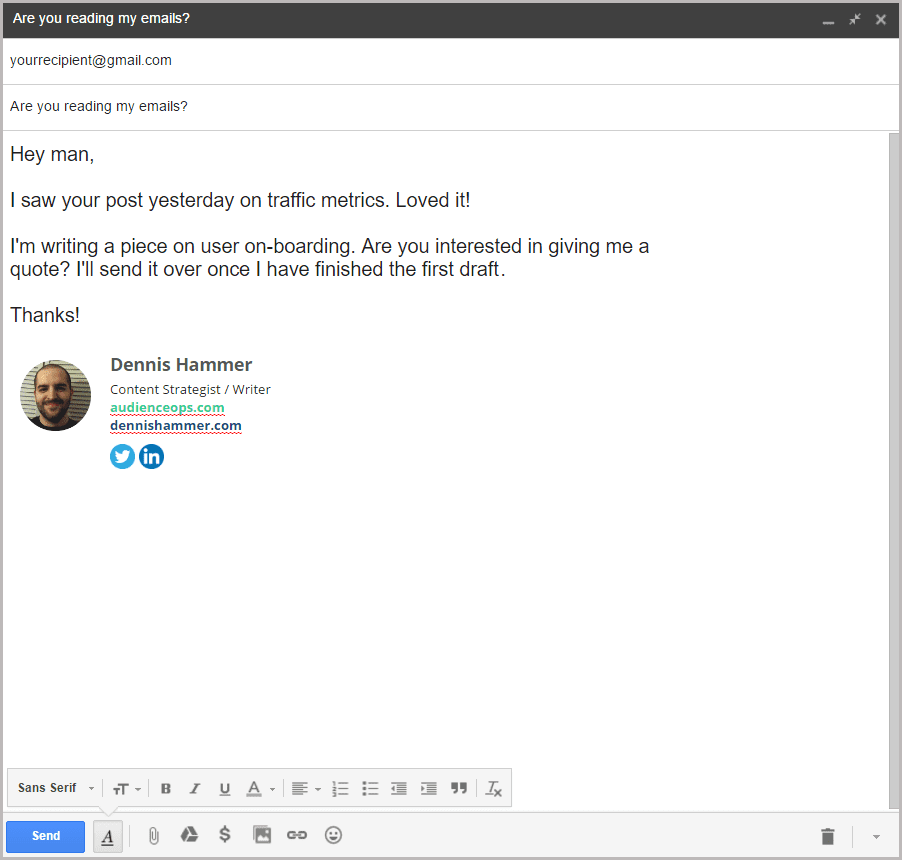Do you ever feel like your emails aren’t being read? You were sure the recipient would be interested in your message, but nothing came back. Whether you’re emailing your boss, your teammates, your partners, or your subscribers, dead silence is frustrating.
“One of the top reasons your email isn’t getting read is because it is too long,” says time management expert Craig Jarrow.
In world that sends 205 billion emails every day (per the Radicati Group), we’re all loaded with incoming messages. If your emails don’t provide immediate value, your recipients will move along.
I’m sure you’ve been on the receiving end of a long email yourself. You open a thread, witness the novella before you and sigh. You think, “Do I have time to read this?” Most people feel that way. Longer emails are less likely to be read and less likely to be read carefully.
Craig goes on to say, “Writing long emails doesn’t mean you are getting more work done.”
Many people hold this weird misconception that there’s value in length, as if saying more equates to doing more. That couldn’t be farther from the truth.
There’s science to this, too. NYU and MIT professors conducted a study that culled five years’ worth of emails. Their conclusion was that shorter emails are more likely to receive a response (or action taken, like a link click). Responses come more quickly, too.
Hyper productive people like Jeff Bezos and Steve Jobs trim their writing to its barest bones. They strip out unnecessary language, sentiment, and fluff. They move projects along and make things happen.
You don’t have to achieve their startling levels of brevity. The point is that you can still transmit value without overwhelming your reader.
Whenever you write, keep in mind that another human has to read it. Follow these three rules:
- The Iron Imperative: Do not waste the reader’s time.
- The Golden Corollary: Treat the reader’s time as more valuable than your own.
- The Impatience Postulate: Assume that your reader is quite impatient and has other things to do.
Essentially, you need to keep those emails short.
What does “short” even mean?

When you were in school, your writing was probably constrained by arbitrary length requirements. It had to be 2,000 words or three double-spaced pages. But real writing (the kind that moves projects, grows businesses, and makes money) doesn’t work like that.
All writing should only be as long as it needs to fulfill its purpose. You can get away with some extra fluff in a blog post, whitepaper, or eBook. After all, what’s an extra ten words amidst thousands?
In emails, however, you have less leeway. You need to be concise wherever possible. Some emails have to be long because their purpose requires length. If you’re assigning a 12-step project to your team, it will probably require more than 50 words. Your goal should be to pare it down as much as possible without sacrificing quality.
Some people are adopting the five.sentenc.es policy, but I find it too rigid. I don’t recommend adhering to hard rules for written copy because your purpose is most important, but you should constantly seek to pack more meaning in fewer words.
Start With Your Purpose
Before you start writing, mentally acknowledge why you’re sending an email in the first place. Are you asking your friend for help? Are you announcing a new blog post to your subscribers? Are you soliciting your users for feedback? Are you helping onboard a new customer?
It may help to write your purpose at the top of your document. You’ll delete this later, but it will keep you on track if you find yourself rambling.
Once you have your purpose, write only the points that support it. At Audience Ops, we create newsletters for our clients (and ourselves) that are written with two or three paragraphs in plain text. Our data shows better responses than professionally designed HTML emails with long copy.
If you feel the need to say something off topic, save it for another email thread. Email is free, so don’t be afraid to use multiple messages with their own subject lines to keep discussions separated for clarity.
Copywriting Tips for Short Emails

Generally, there are two effective ways to start an email.
- Acknowledge the reader’s problem. Example: “Business owners like yourself don’t have time to view dozens of new office locations.”
- Dive right into your purpose. Example: “My company will arrange office space viewings and eliminate the ones that don’t meet your needs.”
After your opening, add supporting copy, but don’t deviate from your purpose.
Mark Twain once said, “I didn’t have time to write a short letter, so I wrote a long one instead.” That’s because writing a short message takes longer, at least at first. Over time you’ll become accustomed to driving to the point quickly.
Keep your emails short with these tips.
1. Edit everything. Then edit again.
Your first draft of anything is terrible. The best writers in the world admit they can produce some awful first drafts. Once you accept your own imperfections, your writing will come out with force.
But that’s alright! Use the first pass as an opportunity to put down your thoughts. Don’t worry about prose, syntax, or flow.
Once you’ve said everything you can, go back to the top. Organize your thoughts. Create a flow where supporting points follow the main theme. Cut out anything that doesn’t support your purpose. Look for words to excise.
2. Stop worrying about word counts.
Amateur writers aim for word counts, as if the reader will delete the message if it’s not long enough. Honestly, I’m not sure why people do this. There’s no inherent value to length.
Length is irrelevant. Your message should be just as long as it needs to get your point across and no longer.
3. Stop pulling your punches.
“Hey, if it’s not too much trouble and you have the time, I was wondering if you could help me understand this data. I’m not good with these things and I’m not sure where to start. I think it shows that Twitter is a good place for me to promote my articles. Any thoughts?”
Stuff like that makes me cringe. It’s a lot of fluff.
- Don’t apologize for making requests. If I want to reply with a “no,” I will.
- “I’m not good with…” is defeatist and makes me not want to help.
- “Not sure where to start” isn’t true. You’re starting by asking.
The sender spends a lot of time writing what boils down to a simple request. If you are making a request, don’t burden the receiver with extra reading. Get to the point. Here is some better phrasing.
“Hey, what do you think of this data? Looks like I should promote more on Twitter. Any thoughts?”
4. Skip the introductions.
You don’t need to ease the reader into your message, especially when you know the receiver, but even if you’re cold emailing a stranger. Your first words should be intriguing, not dry.
Bad: “Hi, I’m Dennis, a content marketer and writer from Connecticut who’s looking to make connections with marketing brands.”
Good: “Hi, I’m Dennis. I have a way to send targeted traffic to your site.”
Never start with an apology like “Sorry to bother…” It’s weak and unconfident.
5. Remember that people love lists and headings.
You use them in blog posts, but they work in emails too. Trim your copy by eliminating words like “firstly” or “on the other hand.” If you have a lot of data, most email clients let you easily create a table.
6. Trim unnecessary words.
Unnecessary words take up space and confuse your purpose. Opt for lean sentences that shorten your copy and add clarity. Here’s a list of words you can usually skip.
- Very
- Therefore
- Thing (use something else)
- As a result
- Considerable
- Really
- Just
- Definitely
- Up (as in “freed up”)
- Quite
- Perhaps
- Like
- Amazing
- Literally
- Stuff
Oh, and don’t be a jerk.
Brevity doesn’t mean you have to be cold or callous. Jobs and Bezos could get away with it at their level of the game, but you probably can’t.
It’s alright to thank the recipient for something (“Thanks for sending those designs”) or wish them well (“Have a fun vacation”). We’re humans, after all, and we enjoy pleasant conversation. Just don’t let your pleasantries disrupt your purpose.
If you’d like some in-depth training (including how to create great emails), check out our Content Marketing Game Plan.